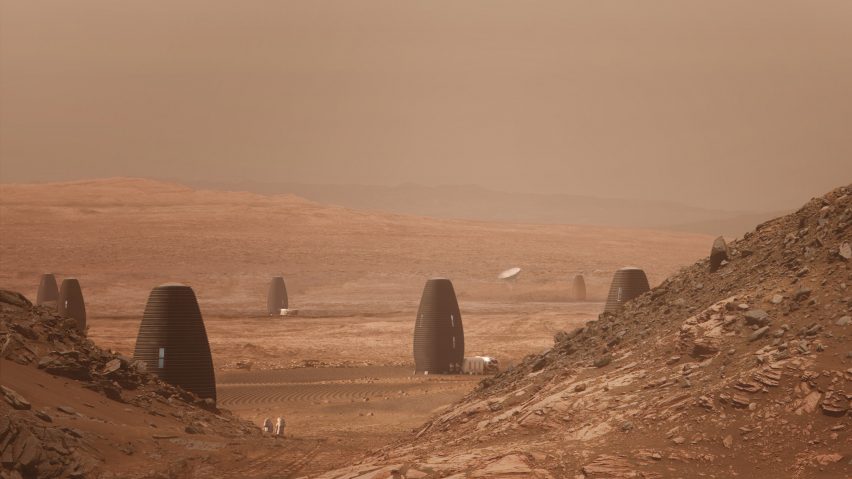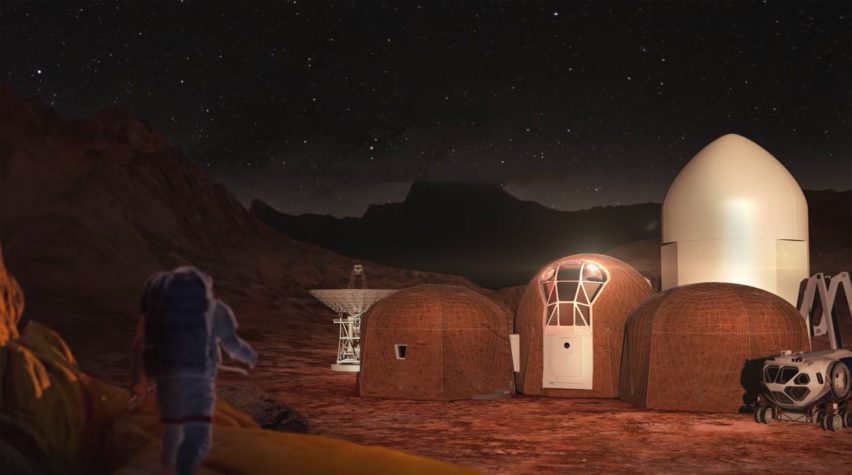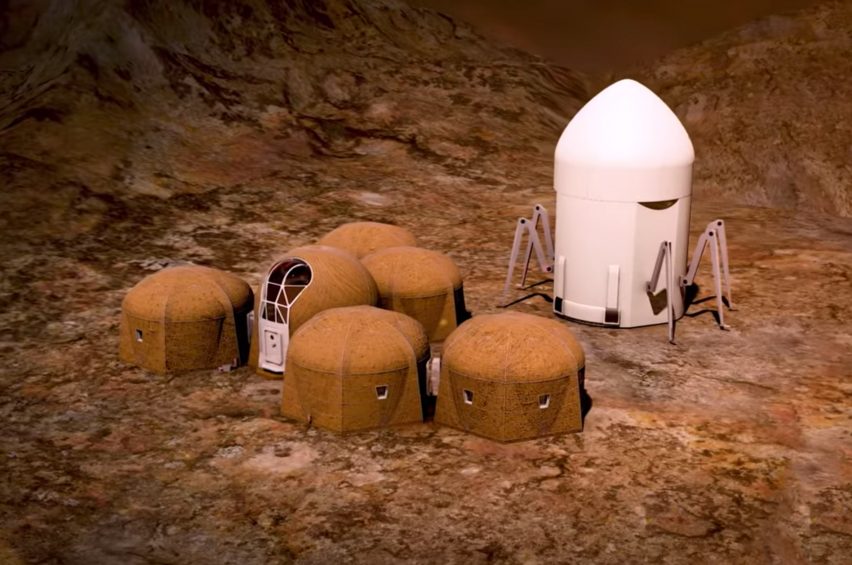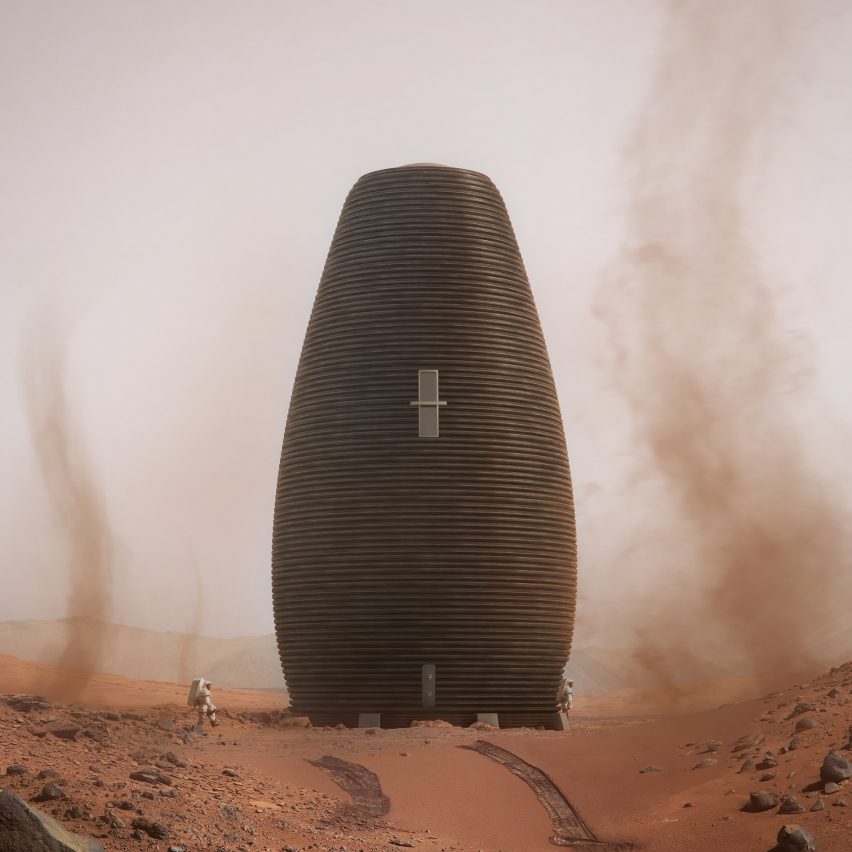
NASA announces winners of competition to design 3D-printed habitat for Mars
NASA has selected the five winning designs in the latest stage of its 3D-printed Habitat competition, which include a community of modular pods made from the Martian surface, and a vertical egg-like container.
The On-Site Habitat Competition invited groups to design a sustainable shelter for a crew of four astronauts on a mission to Mars, using construction techniques enabled by 3D printing technology.
Teams had to come up with a solution that tackles the issues of transporting materials from Earth to Mars, as well as the differences in atmosphere and landscape on the new planet.
Each was required to create digital representations of the physical and functional characteristics of a house on Mars using specialised software tools.

"We are thrilled to see the success of this diverse group of teams that have approached this competition in their own unique styles," said Monsi Roman, programme manager for NASA's series of Centennial Challenges.
"They are not just designing structures, they are designing habitats that will allow our space explorers to live and work on other planets. We are excited to see their designs come to life as the competition moves forward."
The top five teams were selected by NASA in partnership with Bradley University of Peoria, Illinois, out of 18 groups from around the globe. Ranked using a points system, they will all share part of a $100,000 prize depending on what score they achieved.
The winning Zopherus habitat is built from materials taken from the Martian surface
Arkansas-based team Zopherus was awarded first place with its modular habitat for humans on Mars, 3D-printed without human interference with materials made from the Martian surface.
In the concept, a lander would scan its surroundings and select an optimum print area, while autonomous robots are deployed from the vessel to gather materials for the 3D printer.
The lander seals to the ground to provide a protected, pressurised print environment, and then mixes materials, and begins to print the hexagonal structure.

Thanks to its hexagonal structure, multiple Zopherus habitats can be printed to stand close to one another, creating a community.
Each structure is built using a specialised composite Martian concrete material – made from ice, calcium oxide and Martian aggregate – which are collected by rovers and fed into the lander for mixing.
A large window on the mezzanine level of each habitat provides expansive views of the Martian landscape, as well as allowing light to nurture a small hydroponic garden for growth of vegetation and production of oxygen.
AI SpaceFactory's habitat boasts an egg-shaped design to deal with atmospheric pressure
AI SpaceFactory came in second place with its vertical, egg-shaped structure, which is designed with a double shell system to deal with the internal atmospheric pressure and structural stresses that would occur on Mars.
Like the Zopherus habitat, the Marsha design is made using materials harvested from the Martian surface, removing the dependency on rockets to transport materials from Earth.

The team developed an innovative mixture of basalt fibre, extracted from Martian rock, and renewable bioplastic (polylactic acid) derived from plants that would be grown on Mars.
Unlike the communal format of the Zopherus habitats, each Marsha habitat stands alone as a separate structure.
Kahn-Yates' design features a series of holes to allow daylight in
Third place team Kahn-Yates also designed its habitats as individual volumes, with sleek, oblong forms intended to minimise the impact from potential dust storms.
After the space-faring module arrives on Mars, its exterior shell would split off as it lands, leaving behind a pre-fabricated core. After landing, a five-axis print arm would extends from the top of the core and print a foundation using materials found on the Martian landscape.
The arm then prints a concrete shell, while secondary nozzles print HDPE (high-density polyethylene) layers on either side of the shell, effectively sandwiching the Martian concrete in the middle.
Daylight is allowed into the habitat by means of reducing or eliminating portions of the central concrete layer in the exterior shell makeup, to have just the HDPE layers as the skin. This would aid gardening and food production, according to the team.
SEArch+/Apis Cor's habitat features a double-shell structure to provide protection from solar radiation
In fourth place is SEArch+/Apis Cor, which submitted a habitat boasting a double-shell design to shelter the structure from galactic solar radiation. The habitat designed by the fifth-place team, Northwestern University, features a unique spherical shell and outer parabolic dome.
The On-Site Habitat Competition is the third phase in NASA's 3D-Printed Habitat Centennial Challenge, which was created to explore construction technologies needed to create sustainable housing solutions on Earth, the Moon, Mars and beyond.
Northwestern University designed a dome-shaped habitat with a unique entryway system
Phase one, the Design Competition, took place in 2015 and required teams to submit architectural renderings. Submissions included Foster + Partners' proposal for a 93-square-metre habitat printed from regolith, the loose soil and rocks found on the surface of the Red Planet.
Phase two, the Structural Member Competition, took place in 2016-2017 and focused on material technologies, asking teams to create structural components.
There are still four more phases of the challenge to follow, culminating in a head-to-head print of finalists' designs in early 2019.